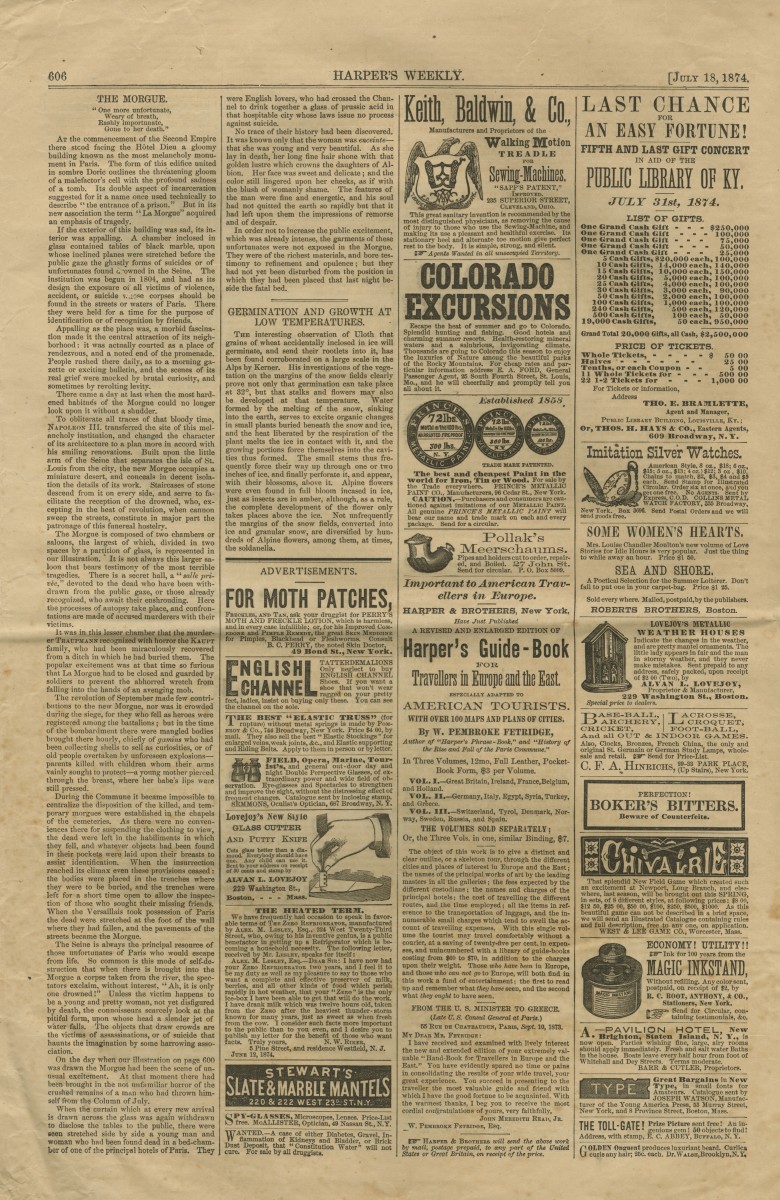The Japanese Pillar Print. Hashira-e. Jacob Pins. Foreword by Roger Keyes. Robert G. Sawers Publishing, London, 1982 [LIB-1543.2018 in this collection] -> page 262 №703: A young woman dreaming of rape and robbery. 1783. Hirano.
MFA: ACCESSION NUMBER 21.5546: Young Woman Music Teacher Dreaming of a Robbery [追剥の夢を見る三味線師匠]. Edo period, about 1783 (Tenmei 3). Artist Torii Kiyonaga (1752–1815), Publisher Nishimuraya Yohachi (Eijudô). Harvard Museums Object Number 1916.586: Female Musician Dreaming of Robbery. Edo period, circa 1783. Torii Kiyonaga, Japanese (1752 - 1815) . Published by Nishimuraya Yohachi.-
 Torii Kiyonaga (1752-1815) Color woodblock print: hashira-e, 68.9 x 12.1 cm. DATE: 1783. Signed: Kiyonaga ga Publisher: Eijudō (Nishimuraya Yohachi) "Young musician dreams of being abducted by a ruffian. Long hours on duty have exhausted this young musician who sits sleeping with her shamisen and book placed on the ground in front of her. In her dream, she is being abducted by a ruffian who has stripped her of her clothing" [LIB-1474.2018: Important Japanese prints from the collection of Henry Steiner. Catalogue № 14. — NY: Sebastian Izzard LLC, 2018.]
Torii Kiyonaga (1752-1815) Color woodblock print: hashira-e, 68.9 x 12.1 cm. DATE: 1783. Signed: Kiyonaga ga Publisher: Eijudō (Nishimuraya Yohachi) "Young musician dreams of being abducted by a ruffian. Long hours on duty have exhausted this young musician who sits sleeping with her shamisen and book placed on the ground in front of her. In her dream, she is being abducted by a ruffian who has stripped her of her clothing" [LIB-1474.2018: Important Japanese prints from the collection of Henry Steiner. Catalogue № 14. — NY: Sebastian Izzard LLC, 2018.] -
 Torii Kiyomitsu II (Kiyomine), Japanese, 1787–1868. Courtesan and her Komura (Doll Festival). Series: Furyu Goyo no Matsu (Customs of 5 Pine Needles, the 5 great festivals). Publisher: Tsuruya Kiemon [Marks: 553].
Torii Kiyomitsu II (Kiyomine), Japanese, 1787–1868. Courtesan and her Komura (Doll Festival). Series: Furyu Goyo no Matsu (Customs of 5 Pine Needles, the 5 great festivals). Publisher: Tsuruya Kiemon [Marks: 553]. -
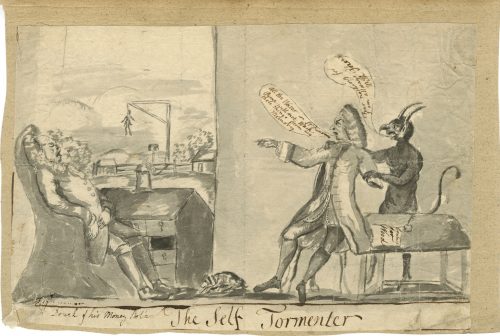 Ink drawing on watermarked paper by an anonymous artist, British or American. Original pen and ink with manuscript text. About 7 x 10-1/2 inches, Vander Ley type watermark (Churchill 321), mounted to old laid paper; several corners chipped, some creasing, soiling, etc. Np, Late 18th-century.
Ink drawing on watermarked paper by an anonymous artist, British or American. Original pen and ink with manuscript text. About 7 x 10-1/2 inches, Vander Ley type watermark (Churchill 321), mounted to old laid paper; several corners chipped, some creasing, soiling, etc. Np, Late 18th-century. -
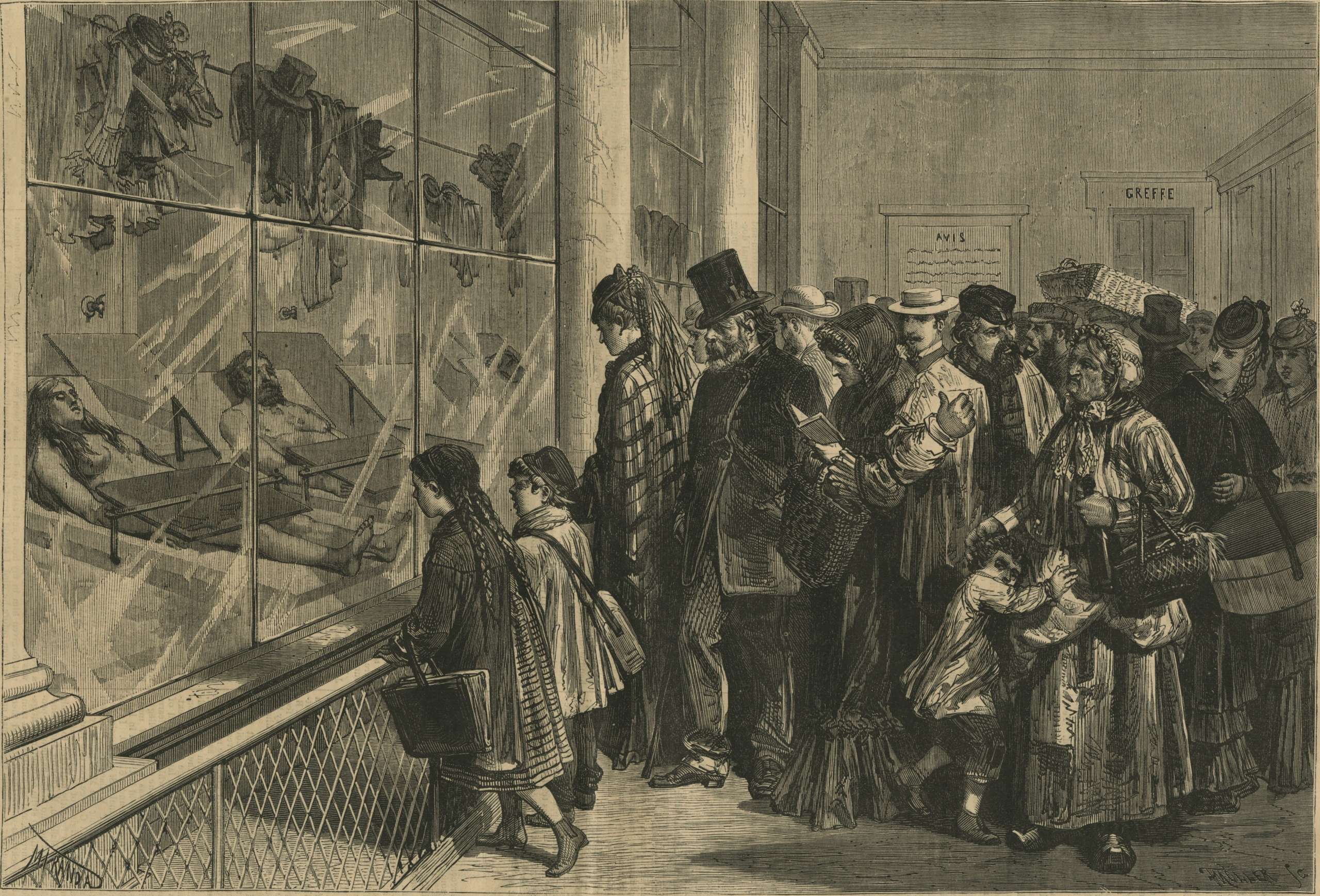
-
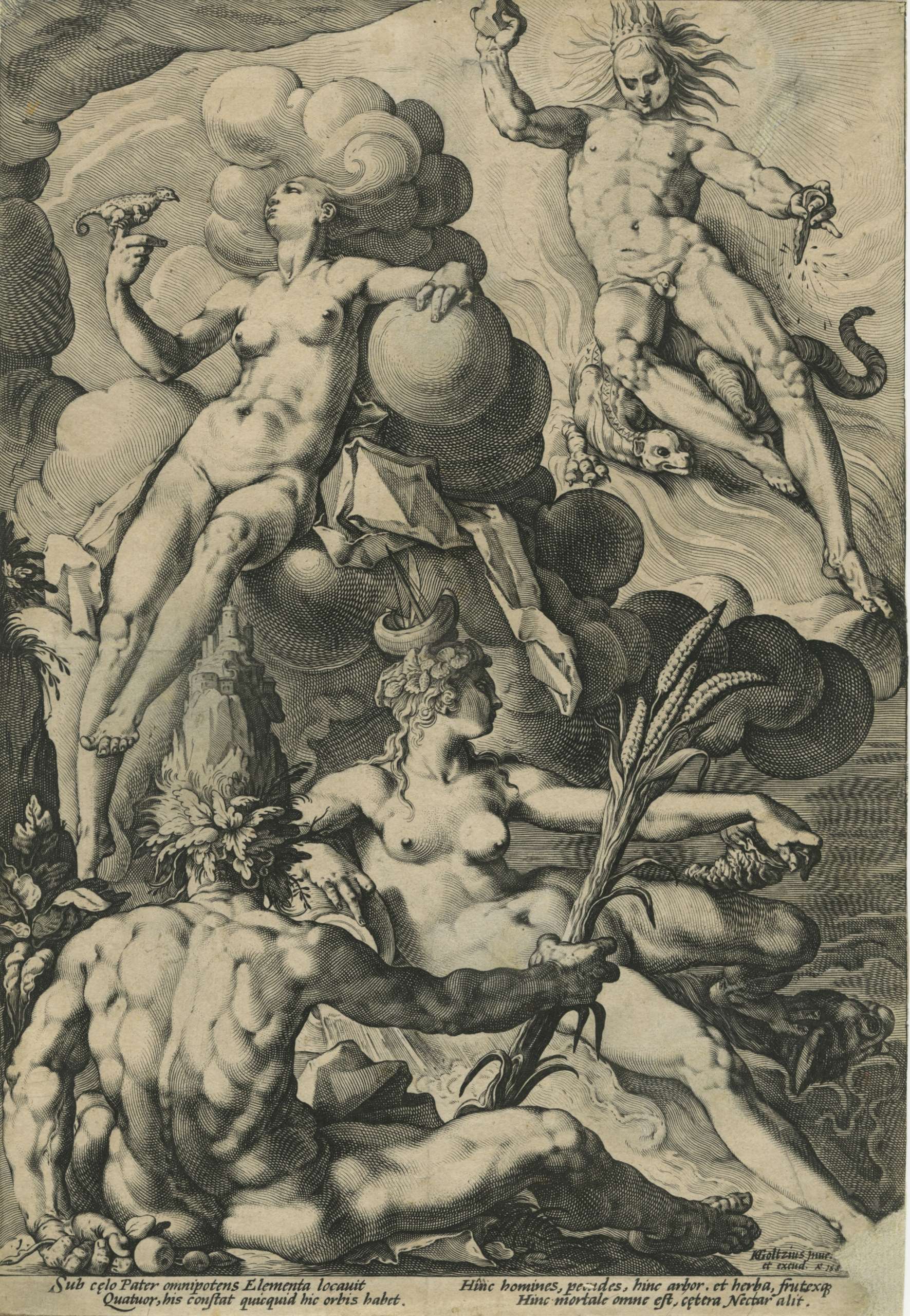
The Four Elements by Jacob Matham (Netherlandish, Haarlem 1571–1631 Haarlem) after Hendrick Goltzius (Netherlandish, Mühlbracht 1558–1617 Haarlem). Engraving on copper, printed on laid paper, 1588.
Dimensions: 298 mm × 206 mm.
-
 London: Published under the superintendence of the Society for the Diffusion of Useful Knowledge; Charles Knight & Co., no. 22 Ludgate Street. Dimensions: Sheet: 34 x 41.8 cm: Image: 28.7 x 38.3 cm. J. & C. Walker, Society for the Diffusion of Useful Knowledge Charles Knight & Co.; Charles Knight (British, 1791 – 1873) – publisher. J & C Walker (British firm, fl. 1820 – 1895) Walker, John (British, 1787 – 1873) Walker, Alexander (British, 1797? – 1870) Walker, Charles (British, 1799? – 1872) Society for the Diffusion of Useful Knowledge (SDUK) (British firm, 1826 – 1846)
London: Published under the superintendence of the Society for the Diffusion of Useful Knowledge; Charles Knight & Co., no. 22 Ludgate Street. Dimensions: Sheet: 34 x 41.8 cm: Image: 28.7 x 38.3 cm. J. & C. Walker, Society for the Diffusion of Useful Knowledge Charles Knight & Co.; Charles Knight (British, 1791 – 1873) – publisher. J & C Walker (British firm, fl. 1820 – 1895) Walker, John (British, 1787 – 1873) Walker, Alexander (British, 1797? – 1870) Walker, Charles (British, 1799? – 1872) Society for the Diffusion of Useful Knowledge (SDUK) (British firm, 1826 – 1846) -
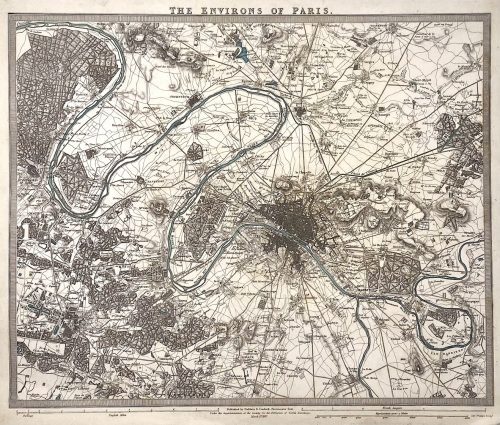 Top: THE ENVIRONS OF PARIS. || Bottom centre: Published by Baldwin & Cradock, Paternoster Row, | Under the Superintendence of the Society for the Diffusion of Useful Knowledge. | March 1st. 1832. || Bottom right: J. & C. Walker sculpt. || Dimensions: Sheet: 34.7 x 40.5 cm; Image: 30 x 37 cm. Contributors: J & C Walker (British firm, fl. 1820 – 1895) Walker, John (British, 1787 – 1873) Walker, Alexander (British, 1797? – 1870) Walker, Charles (British, 1799? – 1872) Society for the Diffusion of Useful Knowledge (SDUK) (British firm, 1826 – 1846)
Top: THE ENVIRONS OF PARIS. || Bottom centre: Published by Baldwin & Cradock, Paternoster Row, | Under the Superintendence of the Society for the Diffusion of Useful Knowledge. | March 1st. 1832. || Bottom right: J. & C. Walker sculpt. || Dimensions: Sheet: 34.7 x 40.5 cm; Image: 30 x 37 cm. Contributors: J & C Walker (British firm, fl. 1820 – 1895) Walker, John (British, 1787 – 1873) Walker, Alexander (British, 1797? – 1870) Walker, Charles (British, 1799? – 1872) Society for the Diffusion of Useful Knowledge (SDUK) (British firm, 1826 – 1846) -
 Suzuki Harunobu (鈴木 春信; c. 1725 – 15 July 1770).
Suzuki Harunobu (鈴木 春信; c. 1725 – 15 July 1770).The Ide Jewel River, a Famous Place in Yamashiro Province (Ide no Tamagawa, Yamashiro no meisho), from the series The Six Jewel Rivers in Popular Customs (Fûzoku Mu Tamagawa).
Signed: Harunobu gaInscription - Poem: Koma tomete/ nao mizu kawan/ yamabuki no/ hana no tsuyu sou/ Ide no Tamagawa
References:MFA # 21.4540.
Waterhouse cat. #562; Pins, The Japanese Pillar Print (1982), #139; Ukiyo-e shûka 4 (1979), list #795.4, and supp. 2 (1982), pl. 565; Gentles, AIC cat. II (1965), p. 125, #201.
-
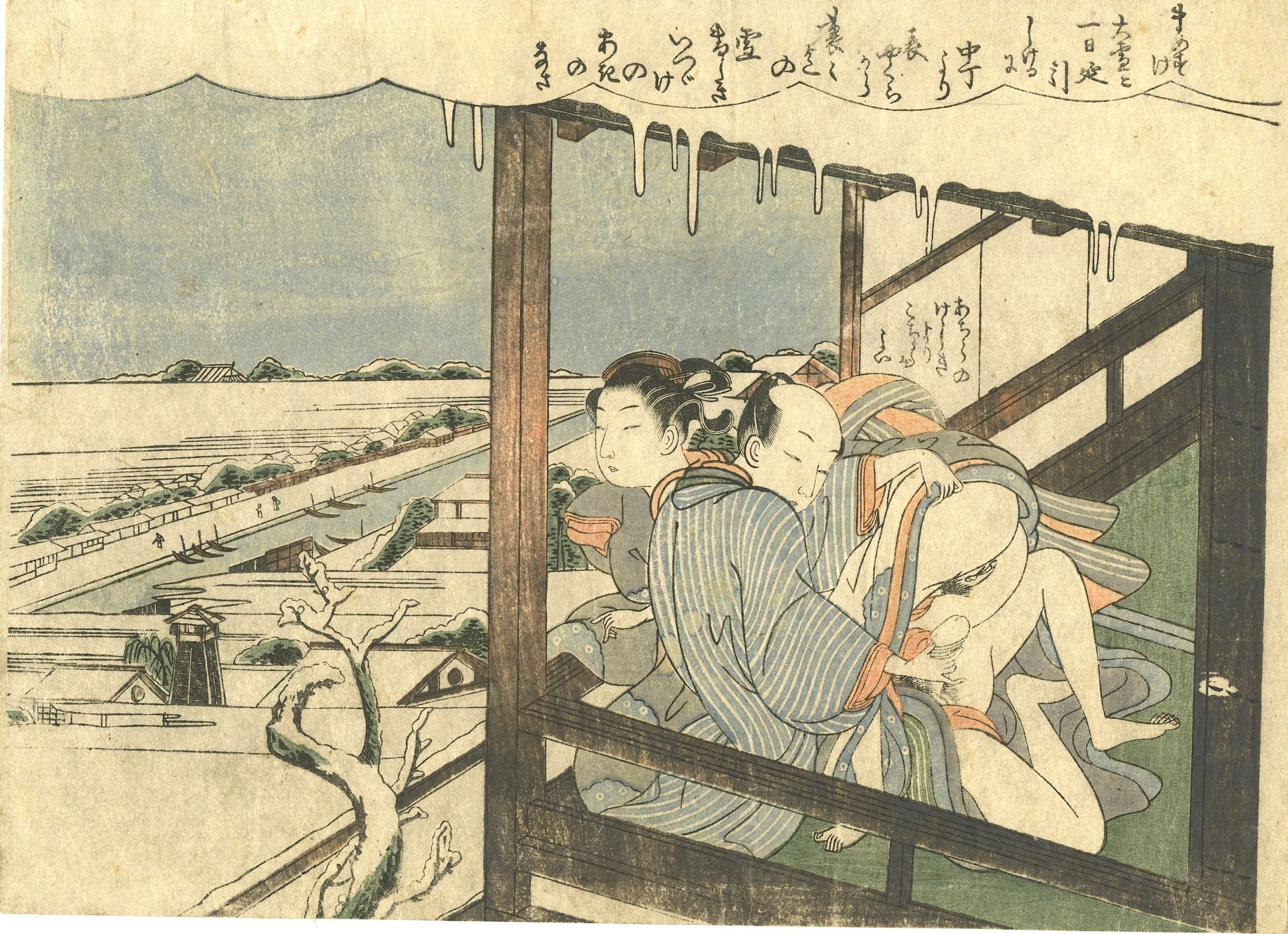 Unsigned print, attributed to Suzuki Harunobu. Erotic scene on open veranda with a winter landscape on background.
Unsigned print, attributed to Suzuki Harunobu. Erotic scene on open veranda with a winter landscape on background. -
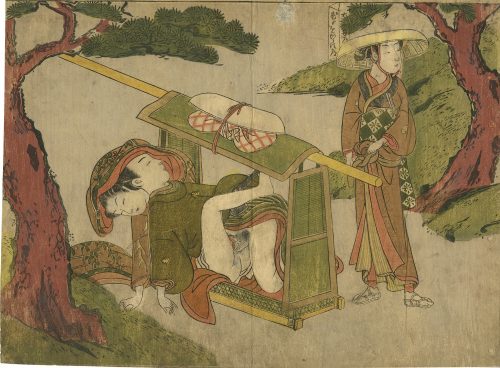 A shunga (erotic) print by Suzuki Harunobu [鈴木 春信] (Japanese, c. 1725 – 1770) depicting a woman making love with a man in the palanquin (のりもの/乗り物) while the other woman "ties a sash about her hips below her obi." The sheet is not signed; however, it is attributed to Harunobu. A reference image can be found in the Metropolitan Museum (NY) collection, Accession Number JP1635:According to the MET "the palanquin ... has carried these courtesans to the shore for a spring outing". Some time ago, a similar print was sold by Richard Kruml (description: A chuban shunga print showing the occupant of a kago in flagrante with one of the porters, having seized the opportunity of a stop on the journey. Published late 1760s. Rare). Another copy was sold at Sotheby's in Paris for €3,360 on November 27, 2002 (Lot 24), with a reproduction of the print's detail and description on p. 39: Suzuki Harunobu (1725 – 1770) | Shunga: couple dans un palanquin, vers 1768-1770, non-signe, cachet non identifé, cachets Charles Mitchell, Huguette Berès, Format chuban, 20.1 x 28.6 cm | 3000 – 4000 € | Il s’agit probablement de trois voyageurs, l’un d’entre eux debout près du palanquin faisant mine d’ignorer la scène. Bibliographie: Delay p. 87. Reference: [LIB-3121.2022] Sotheby's: Collection Huguette Berès – Estampes, dessins et livres illustrés japonais / 2 volumes; vol. 1. — Paris: Sotheby's, 2002.
A shunga (erotic) print by Suzuki Harunobu [鈴木 春信] (Japanese, c. 1725 – 1770) depicting a woman making love with a man in the palanquin (のりもの/乗り物) while the other woman "ties a sash about her hips below her obi." The sheet is not signed; however, it is attributed to Harunobu. A reference image can be found in the Metropolitan Museum (NY) collection, Accession Number JP1635:According to the MET "the palanquin ... has carried these courtesans to the shore for a spring outing". Some time ago, a similar print was sold by Richard Kruml (description: A chuban shunga print showing the occupant of a kago in flagrante with one of the porters, having seized the opportunity of a stop on the journey. Published late 1760s. Rare). Another copy was sold at Sotheby's in Paris for €3,360 on November 27, 2002 (Lot 24), with a reproduction of the print's detail and description on p. 39: Suzuki Harunobu (1725 – 1770) | Shunga: couple dans un palanquin, vers 1768-1770, non-signe, cachet non identifé, cachets Charles Mitchell, Huguette Berès, Format chuban, 20.1 x 28.6 cm | 3000 – 4000 € | Il s’agit probablement de trois voyageurs, l’un d’entre eux debout près du palanquin faisant mine d’ignorer la scène. Bibliographie: Delay p. 87. Reference: [LIB-3121.2022] Sotheby's: Collection Huguette Berès – Estampes, dessins et livres illustrés japonais / 2 volumes; vol. 1. — Paris: Sotheby's, 2002.
http://www.metmuseum.org/art/collection/search/45071
-
 Artist (attributed, no signature): Suzuki Harunobu [鈴木 春信] (Japanese, c. 1725 – 1770). The title is taken from [LIB-1478.2013] Gian Carlo Calza, Stefania Piotti. Poem of the pillow and other stories. — Phaidon Press, 2010; pp. 148-9. Alternative title: Man sucking woman's breast and a cat sitting under a bonsai tree. The open book beside the couple reads 子春 (Koharu). Woodblock print from the series Mirror Picture of Japan (Wakoku kagami); Size: Horizontal chuban; 21 x 26 cm.
Artist (attributed, no signature): Suzuki Harunobu [鈴木 春信] (Japanese, c. 1725 – 1770). The title is taken from [LIB-1478.2013] Gian Carlo Calza, Stefania Piotti. Poem of the pillow and other stories. — Phaidon Press, 2010; pp. 148-9. Alternative title: Man sucking woman's breast and a cat sitting under a bonsai tree. The open book beside the couple reads 子春 (Koharu). Woodblock print from the series Mirror Picture of Japan (Wakoku kagami); Size: Horizontal chuban; 21 x 26 cm. -
 The print lacks signature. It is attributed by some to Suzuki Harunobu and by the others to Isoda Koryūsai.
The print lacks signature. It is attributed by some to Suzuki Harunobu and by the others to Isoda Koryūsai.Attributed to Koryūsai: Pins #517/p.209, c. 1775 [AIC II: Clarence Buckingham Collection, 1925.2772], Ukiyo-e Taisei IV; Vignier & Inada, 1911; Ritsumeikan University Z0165-239.
Attributed to Harunobu: Pins #239/p.132.; BM 1906,1220,0.85;
-
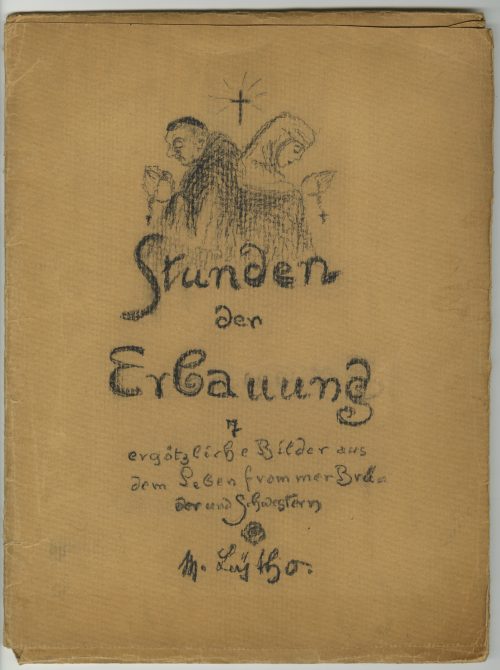 Flapped folder of thick embossed paper 353 x 263 mm, with a vignette and manuscript to front: Stunden der Erbauung | 7 | ergötz liebe Bilder aus | dem Leben frommer Brü | der und Schwestern | • | M. Leÿtho. ||, six graphite pencil drawings, each glued to a paper sheet with guard tissue; mat size 339 x 253 mm mat; drawing size 220 x 165 mm. Translation of the title: Hours of Edification / 7 delightful pictures from the lives of pious brothers and sisters. Information about the artist at www.honesterotica.com: "Mitja Leytho, almost certainly a pseudonym, is yet another mediocre yet fascinating amateur artist from the Germany of the 1920s about whom we know absolutely nothing beyond the four portfolios which bear the ‘Leytho’ signature".
Flapped folder of thick embossed paper 353 x 263 mm, with a vignette and manuscript to front: Stunden der Erbauung | 7 | ergötz liebe Bilder aus | dem Leben frommer Brü | der und Schwestern | • | M. Leÿtho. ||, six graphite pencil drawings, each glued to a paper sheet with guard tissue; mat size 339 x 253 mm mat; drawing size 220 x 165 mm. Translation of the title: Hours of Edification / 7 delightful pictures from the lives of pious brothers and sisters. Information about the artist at www.honesterotica.com: "Mitja Leytho, almost certainly a pseudonym, is yet another mediocre yet fascinating amateur artist from the Germany of the 1920s about whom we know absolutely nothing beyond the four portfolios which bear the ‘Leytho’ signature". -
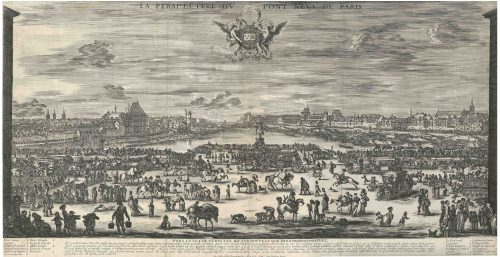
Etching on laid paper, backed. Massar (1971): 59-61. View of the Pont Neuf in Paris, with the statue of Henry IV at centre in front of the Seine, the church of St.-Germaine l'Auxerrois and the Louvre to the right, and the Hôtel de Nevers and Tour de Nesle to the left (MET). in the banner below: LUDOVICO XIIII GALLIARUM ET NAV REGI; below image: PONS LVTETIÆ STRVCTVS, DICTVS NOVVS, ET QVÆ EX EO PROSPICI POSSVNT.; bellow: En pulcherrimus toto ... caufatus, vifere; along the bottom: Ste. Della Bella Florentinus In. e Fecit DD. 1646. Cum Privilegio Regis; additional lettering a lower left and right identifying places depicted.
State: 2nd, with the weathercock on the belltower of Église Saint-Germain l'Auxerrois (under 8). Size: 35.5 x 67.6 cm. Condition: Three vertical folds, these partly cracked and backed at the bottom, dusty or slightly stained, partly slightly rubbed, a small diagonal crease on the upper left, tiny marginal blemishes.Quotation from Phyllis D. Massar. Presenting Stefano della Bella. — NY: The Metropolitan Museum of Art, [1971]: "For size and complexity, one of Della Bella's most impressive achievements is his view of Paris across the Pont Neuf from a point between the buildings bounding the Place Dauphine. Besides the well-known landmarks-the Hộtel de Nevers, the Tour de Nesle, the church of Saint Germain l'Auxerrois, and, at the centre, the bronze equestrian statue of Henri IV by the Florentines Giovanni Bologna and Pietro Tacca – the print provides a microcosm of Paris in transit across the Seine. With a glass, one can compile a census of 451 people, thirty-eight horses, nineteen dogs, three donkeys, and one lamb. All but lost in the vast scene, nevertheless, all contributing to it, are duelists, men fighting with staffs, brawlers routing passers-by, a tooth-puller making an extraction, sellers of sweetmeats and fruits, falconers, hunters with a pack of dogs, a legless cripple, many begging gypsies (one of them telling a fortune), and a hurdy-gurdy player with an audience. Moving among the splendid carriages is a humble water cart, and back among the market stands at the right is an early Seine-side bookstall."
Catalogue raisonné: Massar (1971): pp. 58-61; De Vesme p. 132, № 850ii/ii. Contributor: Stefano della Bella (Italian, 1610 – 1664) – artist and engraver. -
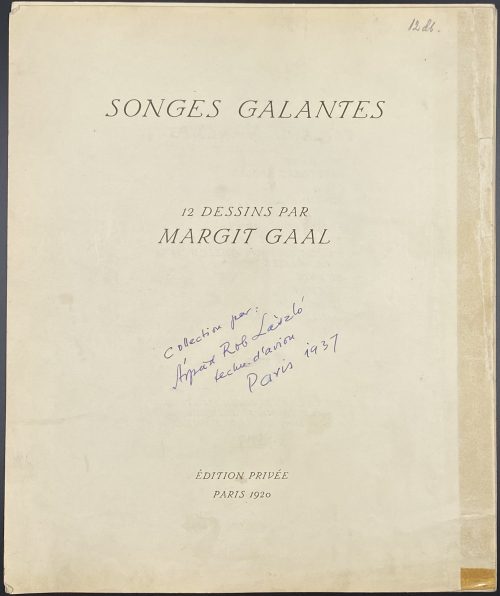 In an owner’s quarter buckram cardboard folder with a vegetation diaper design, ms blue ink lettering to front: “Songes galantes | 12 dessins par | Margit Gaal” at the centre, “Arpad Rob Laszlo | à Paris | 1938” in the lower right corner. Loose sheets with the 1st leaf t.p. / table de planches, and then 12 leaves of lithograph plates. Title-page: SONGES GALANTES | 12 DESSINS PAR | MARGIT GAAL | ÉDITION PRIVÉE | PARIS 1920 ||, ms inscription in blue ink in the middle : “Collection par | Árpad Rob Laśzló | techn. d’avion | Paris 1937”. Limitation: Edition limited to 500 copies of which № 1-100 signed by the author. This is copy № 407. References: Dutel (1920-1970) № 1413 (published in 1921); Honesterotica (indicated the year of death as 1965, however, there is no proof). Contributors: Gaál, Margit (Hungarian, 1898 – 1920) – artist.
In an owner’s quarter buckram cardboard folder with a vegetation diaper design, ms blue ink lettering to front: “Songes galantes | 12 dessins par | Margit Gaal” at the centre, “Arpad Rob Laszlo | à Paris | 1938” in the lower right corner. Loose sheets with the 1st leaf t.p. / table de planches, and then 12 leaves of lithograph plates. Title-page: SONGES GALANTES | 12 DESSINS PAR | MARGIT GAAL | ÉDITION PRIVÉE | PARIS 1920 ||, ms inscription in blue ink in the middle : “Collection par | Árpad Rob Laśzló | techn. d’avion | Paris 1937”. Limitation: Edition limited to 500 copies of which № 1-100 signed by the author. This is copy № 407. References: Dutel (1920-1970) № 1413 (published in 1921); Honesterotica (indicated the year of death as 1965, however, there is no proof). Contributors: Gaál, Margit (Hungarian, 1898 – 1920) – artist. -
 Bando Mitsugorō III as Lady Iwafuji and Nakamura Matsue III as Lady Onoe, 1821.「局岩ふじ 坂東三津五郎」(三代)、「中老尾上 中村松江」(三代) in kabuki play Kagamiyama Kokyô no Nishikie [鏡山旧錦繪] (Mirror mountain: A women’s treasury of loyalty); author: Yô Yôdai. Artist: Shunkōsai Hokushū (春好斎 北洲), who is also known as Shunkō IV, active from about 1802 to 1832. Actors: Bandō Mitsugorō III [三代目 坂東 三津五郎] (Japanese, 1775 – 1831); other names: Bandō Minosuke I, Morita Kanjirô II, Bandō Mitahachi I, Bandō Minosuke I, Bandō Mitahachi I. Nakamura Matsue III [三代目中村松江] (Japanese, 1786-1855); other names: Nakamura Sankō I, Nakamura Tomijūrō II, Ichikawa Kumatarō. Year: 1821 (Bunsei 4), 1st month. Publisher: Wataya Kihei (Wataki) (Japanese, fl. c. 1809 – 1885) Signed Shunkôsai Hokushû ga 春好斎北洲画. MFA Accession № 11.35375. MFA description: "Play: Keisei Kagamiyama (Mirror Mountain, a Courtesan Play). Theatre: Kado けいせい双鏡山(けいせいかがみやま)角. Ref.: [LIB-1193.2013] Leiter. Kabuki Encyclopedia, p. 156; [LIB-0879-2.2015] Kabuki plays on stage (vol. 2): 1773-1799, pp. 172-212.
Bando Mitsugorō III as Lady Iwafuji and Nakamura Matsue III as Lady Onoe, 1821.「局岩ふじ 坂東三津五郎」(三代)、「中老尾上 中村松江」(三代) in kabuki play Kagamiyama Kokyô no Nishikie [鏡山旧錦繪] (Mirror mountain: A women’s treasury of loyalty); author: Yô Yôdai. Artist: Shunkōsai Hokushū (春好斎 北洲), who is also known as Shunkō IV, active from about 1802 to 1832. Actors: Bandō Mitsugorō III [三代目 坂東 三津五郎] (Japanese, 1775 – 1831); other names: Bandō Minosuke I, Morita Kanjirô II, Bandō Mitahachi I, Bandō Minosuke I, Bandō Mitahachi I. Nakamura Matsue III [三代目中村松江] (Japanese, 1786-1855); other names: Nakamura Sankō I, Nakamura Tomijūrō II, Ichikawa Kumatarō. Year: 1821 (Bunsei 4), 1st month. Publisher: Wataya Kihei (Wataki) (Japanese, fl. c. 1809 – 1885) Signed Shunkôsai Hokushû ga 春好斎北洲画. MFA Accession № 11.35375. MFA description: "Play: Keisei Kagamiyama (Mirror Mountain, a Courtesan Play). Theatre: Kado けいせい双鏡山(けいせいかがみやま)角. Ref.: [LIB-1193.2013] Leiter. Kabuki Encyclopedia, p. 156; [LIB-0879-2.2015] Kabuki plays on stage (vol. 2): 1773-1799, pp. 172-212. -
 Bandō Mitsugorō III as Daihanji Kiyozumi and Arashi Koroku IV as Koganosuke in kabuki play Imoseyama, an example of womanly virtue (Imoseyama onna teikin). 大判事清澄 坂東三津五郎」(三代)・「久我之助 嵐小六」(四代) Artist: Shunkōsai Hokushū [春好斎北洲] (Japanese, fl. 1802 – 1832) Year: 1821 (3rd month). MFA description: “The Kabuki play Mount Imo and Mount Se: An Exemplary Tale of Womanly Virtue (Imoseyama onna teikin), originally based on a puppet play, is set in ancient Japan when the Soga clan served as regents to the emperor. Two children, Hinadori and Koganosuke, of rival court families, are held hostage under orders from the tyrant Soga no Iruka to ensure their families do not revolt. The children fall in love, but rather than create conflicts for their families they each vow to die by suicide. When the parents learn of their plans, they resolve to cooperate to overthrow Iruka. Here Koganosuke and his father Kiyozumi are shown; a companion sheet on the left would have shown Hinadori and her mother Sadaka.” The play Imoseyama, an example of womanly virtue (Imoseyama onna teikin), was staged at Osaka's Kado Shibai (Kadoza, Kado Gekijô, Kado no Shibai) from 3/1821. According to Herwig, it is the right sheet of a diptych (see below). MFA Accession number: 2011.128 Kabuki actors: Bandō Mitsugorō III [三代目 坂東 三津五郎] (Japanese, 1775 – 1831); other names: Bandō Minosuke I, Morita Kanjirô II, Bandō Mitahachi I, Bandō Minosuke I, Bandō Mitahachi I. Arashi Koroku IV [四代目嵐小六] (Japanese, 1783 – 1826)
Bandō Mitsugorō III as Daihanji Kiyozumi and Arashi Koroku IV as Koganosuke in kabuki play Imoseyama, an example of womanly virtue (Imoseyama onna teikin). 大判事清澄 坂東三津五郎」(三代)・「久我之助 嵐小六」(四代) Artist: Shunkōsai Hokushū [春好斎北洲] (Japanese, fl. 1802 – 1832) Year: 1821 (3rd month). MFA description: “The Kabuki play Mount Imo and Mount Se: An Exemplary Tale of Womanly Virtue (Imoseyama onna teikin), originally based on a puppet play, is set in ancient Japan when the Soga clan served as regents to the emperor. Two children, Hinadori and Koganosuke, of rival court families, are held hostage under orders from the tyrant Soga no Iruka to ensure their families do not revolt. The children fall in love, but rather than create conflicts for their families they each vow to die by suicide. When the parents learn of their plans, they resolve to cooperate to overthrow Iruka. Here Koganosuke and his father Kiyozumi are shown; a companion sheet on the left would have shown Hinadori and her mother Sadaka.” The play Imoseyama, an example of womanly virtue (Imoseyama onna teikin), was staged at Osaka's Kado Shibai (Kadoza, Kado Gekijô, Kado no Shibai) from 3/1821. According to Herwig, it is the right sheet of a diptych (see below). MFA Accession number: 2011.128 Kabuki actors: Bandō Mitsugorō III [三代目 坂東 三津五郎] (Japanese, 1775 – 1831); other names: Bandō Minosuke I, Morita Kanjirô II, Bandō Mitahachi I, Bandō Minosuke I, Bandō Mitahachi I. Arashi Koroku IV [四代目嵐小六] (Japanese, 1783 – 1826)
Ref.: [LIB-1197.2016] Arendie and Henk Herwig. Heroes of the kabuki stage: an introduction to kabuki with retellings of famous plays, illustrated by woodblock prints. — Amsterdam: Hotei Publishing, 2004; p. 72:
Ref: [LIB-2973.2022] Ukiyo-e: A journey through the Floating World / Exhibition catalogue (Japan, Jan-Jul 2014). — The Yomiuri Shimbun, 2014; № 358, p. 226. "Bandō Mitsugorō III as Grand arbiter Kiyosumi and Arashi Koroku IV as Koganosuke":
-
 Attributed to Suzuki Harunobu (Japanese: 鈴木 春信; c. 1725 – 7 July 1770). Sunga. Woman dreaming of making love. British museum attributes to Ippitsusai Buncho (一筆斉文調).
Attributed to Suzuki Harunobu (Japanese: 鈴木 春信; c. 1725 – 7 July 1770). Sunga. Woman dreaming of making love. British museum attributes to Ippitsusai Buncho (一筆斉文調).



